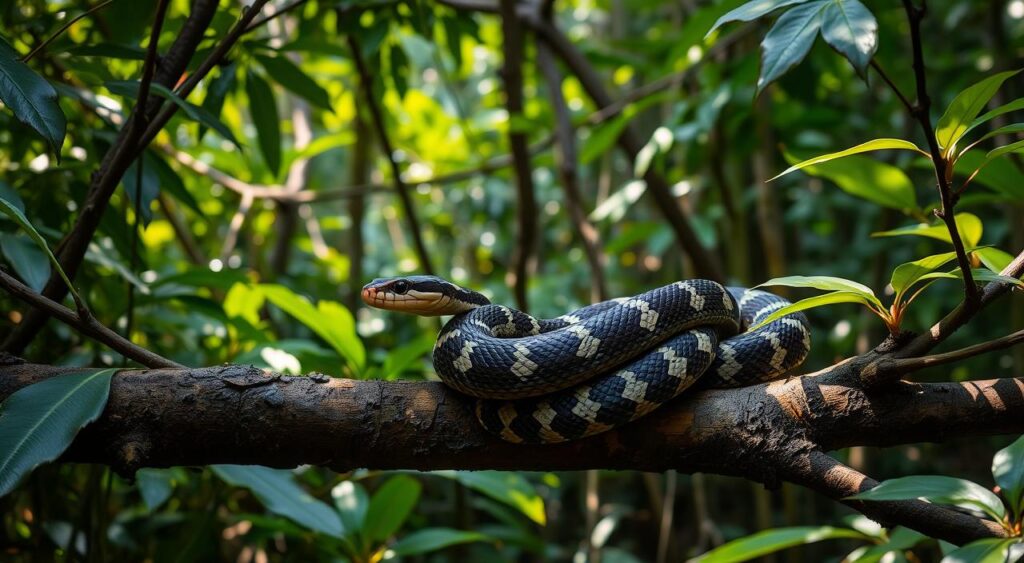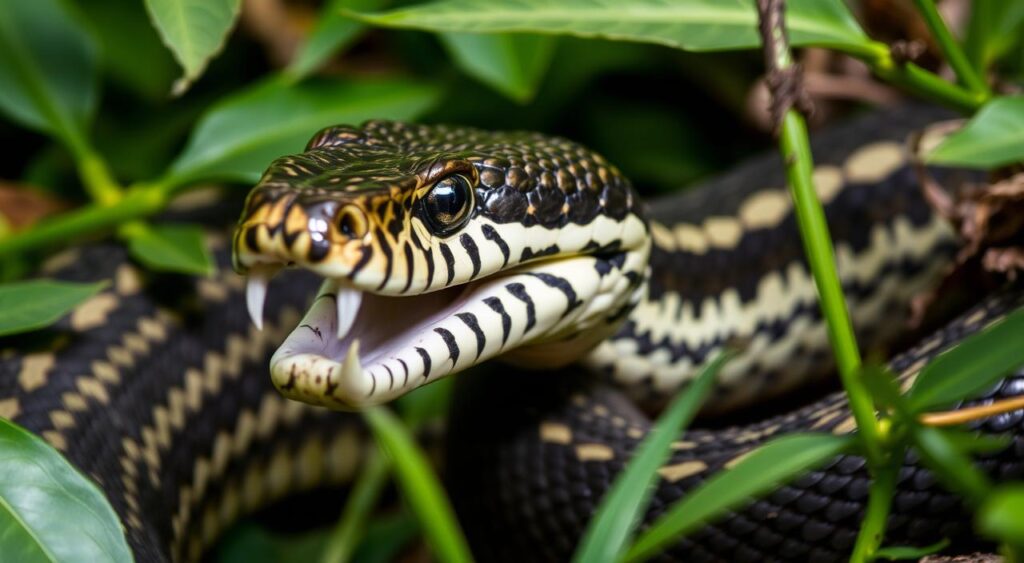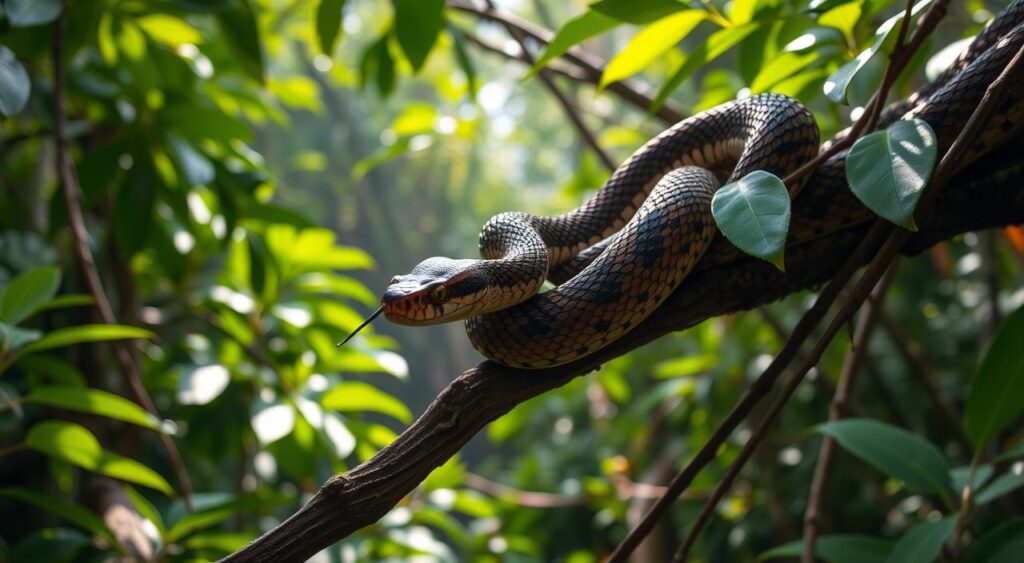What Are Bushmasters: Bushmasters are the biggest venomous snakes in the Americas. They are known for their size, strong venom, and special traits. This article will explore the world of bushmasters. We will look at their species, habits, venom, behavior, habitat, diet, reproduction, and how we can save them.

Key Takeaways
- Bushmasters are the largest venomous snakes in the Americas, known for their impressive size and potent venom.
- These snakes have unique characteristics and a diverse range of species, including the South American Bushmaster and the Central American Bushmaster.
- Bushmasters are nocturnal hunters and ambush predators, with a diet that includes a variety of small mammals, birds, and other reptiles.
- The venom of the Bushmaster is highly potent, with hemotoxic effects that can be life-threatening to humans.
- Conservation efforts are underway to protect Bushmaster populations, which face threats from habitat loss and human encroachment.
Introduction to the Formidable Bushmaster Snake
Bushmasters are fascinating venomous pit vipers found in Central and South America. They are known for their large size, strong venom, and special features. This makes them interesting and respected by many.
Overview of the Bushmaster’s Significance
Bushmasters are the biggest venomous snakes in the Americas. They can grow up to 3.5 metres (11.5 feet) long. Their big, heavy bodies and unique heads, with heat-sensing pits, make them look very powerful.
Key Characteristics of the Bushmaster
Their colours range from brown to grey, with patterns that help them hide in the rainforest and swamps. Their size, venom, and special features make them important predators. They play a key role in keeping the local wildlife balanced.
| Characteristic | Description |
|---|---|
| Size | Up to 3.5 metres (11.5 feet) in length, making them the largest venomous snakes in the Americas |
| Appearance | Robust, heavy-bodied build with a distinct triangular-shaped head and heat-sensing pits for prey detection |
| Colouration | Shades of brown to grey with intricate patterns of dark and light, aiding in camouflage |
| Habitat | Tropical rainforests and swampy areas in Central and South America |
| Significance | Considered a formidable predator in their native ecosystems, playing a crucial role in the local wildlife balance |

What Are Bushmasters
Bushmasters are a type of venomous snake found in Central and South America’s tropical areas. They are known for their size, strong venom, and special features that help them hunt well in their homes.
The term “bushmaster” covers different snake species, like the South American bushmaster and the Central American bushmaster. These snakes can grow up to 3 metres long. They have triangular heads, a sign of pit vipers.
Bushmasters have venom that is very dangerous. Their venom is a hemotoxin, which attacks the blood. It can cause serious bleeding, tissue damage, and even death in humans and big animals. This makes them among the most venomous snakes globally, and they should be treated with great care.

Even though they are dangerous, bushmasters are not usually aggressive. They are shy and like to stay away from people. But, if they feel threatened or cornered, they will defend themselves. This makes them a snake to be careful around in the wild.
In short, bushmasters are big, venomous snakes from Central and South America’s tropical areas. Their size, venom, and special traits make them good hunters. But, they are mostly shy and try to stay away from people.
Bushmaster Snake Species
The bushmaster snake family has two main species: the South American bushmaster and the Central American bushmaster. Both are huge and have very strong venom. They are feared by those who meet them in the wild.
The South American Bushmaster
The South American bushmaster (Lachesis muta) is the biggest of its kind. It lives in the rainforests of South America, like Brazil and Peru. These snakes can grow up to 3.5 metres long, making them among the biggest venomous snakes globally.
The Central American Bushmaster
The Central American bushmaster (Lachesis stenophrys) calls the tropical forests of Central America home. It’s a bit smaller than the South American one, reaching up to 2.5 metres in length.
Both the south american bushmaster and central american bushmaster belong to the bushmaster snake species. They are known for their size, camouflage, and dangerous venom. Humans should be careful not to get too close to them.
Bushmaster Snake Habits
Bushmasters are fascinating reptiles with unique hunting strategies and nocturnal behaviour. They are nocturnal hunters, using their heat-sensing pits to find warm-blooded prey. Bushmasters are ambush predators, staying still and striking fast when prey is close.
Their hunting tactics are very effective. They use their powerful venom to catch small mammals, birds, and other reptiles. This diet helps them thrive in their tropical rainforest and swampy home, making them top predators.
Nocturnal Hunters and Ambush Predators
- Bushmasters are primarily nocturnal, using their heat-sensing pits to detect warm-blooded prey.
- They are ambush predators, remaining motionless and striking quickly when their target approaches.
- Bushmasters employ their potent venom to subdue a wide range of small mammals, birds, and other reptiles.
| Hunting Behaviour | Prey Selection |
|---|---|
| Nocturnal | Small mammals, birds, reptiles |
| Ambush predator | Versatile diet |
| Use of heat-sensing pits | Apex predator in its ecosystem |
Bushmaster Snake Venom
The bushmaster snake is known for its powerful venom. This venom can be very dangerous to humans. It can stop the body’s blood from clotting, leading to bleeding and damage to organs.
Being bitten by a bushmaster snake can cause a lot of pain and swelling. It can also lead to breathing problems or even heart failure if not treated quickly.
Potent Hemotoxic Venom and Its Effects
Bushmasters have venom that attacks the blood’s ability to clot. This makes it hard for the body to stop bleeding. It can cause serious problems like organ failure and bleeding inside the body.
The venom can also cause a lot of pain, swelling, and damage at the bite site. In some cases, it can even cause breathing or heart problems. This shows how important it is to get medical help right away if bitten by a bushmaster.
| Symptom | Description |
|---|---|
| Severe Pain | Intense and debilitating pain at the bite site, often described as excruciating. |
| Swelling | Rapid and significant swelling around the bite area, which can spread to other parts of the body. |
| Internal Bleeding | Disruption of the blood clotting process, leading to uncontrolled internal bleeding and organ damage. |
| Respiratory Distress | In some cases, the venom may affect the respiratory system, causing breathing difficulties. |
| Cardiac Arrest | The venom’s effects on the cardiovascular system can potentially lead to heart failure. |
Getting medical help right away is key if bitten by a bushmaster snake. Antivenom and supportive care can save lives. This shows how important it is to know about the dangers of bushmaster snake venom.
Bushmaster Snake Behaviour
The bushmaster snake is a powerful predator found in Central and South America’s tropical areas. It is known for being shy and preferring to stay hidden. This snake avoids confrontations whenever it can.
But, when threatened, the bushmaster’s behaviour changes. It becomes aggressive and powerful, striking if cornered. Its venom, which affects the blood, makes it even more dangerous.
Bushmasters hunt by ambush, using their camouflage and patience. They wait for prey to come close. Their night hunting and ability to stay still for long periods make them skilled hunters.
| Characteristic | Description |
|---|---|
| Temperament | Generally shy and reclusive, but highly defensive when threatened |
| Venom | Potent hemotoxic venom that can be dangerous to humans |
| Hunting Tactics | Ambush predators, relying on camouflage and patience |
| Activity Patterns | Nocturnal, remaining still for extended periods |
Knowing how bushmaster snakes behave is important. If you meet one, it’s best to keep your distance. This way, you can avoid any dangerous situations.
Bushmaster Snake Habitat
The bushmaster snake lives mainly in the tropical rainforests and swampy lands of Central and South America. These snakes love the dense, humid places with lots of plants and hiding spots. They are key to the ecosystem, hunting and being hunted in their homes.
Tropical Rainforests and Swampy Areas
Bushmasters are perfect for the green, wet world of tropical rainforests. They hide in the thick undergrowth, waiting to catch their prey. They also like the wet, marshy areas for their moisture and shelter.
Their home is vital for their survival. It gives them everything they need to live well. By knowing what they need, we can see why we must protect their bushmaster snake habitat and bushmaster snake environment.
| Habitat Characteristics | Importance for Bushmasters |
|---|---|
| Tropical Rainforests | Provide dense vegetation, cover, and resources for hunting and breeding |
| Swampy Areas | Offer the moisture and refuge required for the snakes to thrive |
| Diverse Ecosystems | Support a variety of prey species and maintain the delicate balance of the environment |
Bushmaster Snake Diet
Bushmasters are big snakes found in tropical rainforests. They eat small mammals, birds, and other reptiles. They use special pits to find warm-blooded prey and strike fast with their venom.
Feeding Habits and Prey Selection
Bushmasters hunt small rodents, rabbits, opossums, and smaller snakes and lizards. They are quick and ambush their prey, making them skilled hunters. They can catch many different types of prey in their home.
| Prey | Frequency of Consumption |
|---|---|
| Small Rodents | Frequent |
| Rabbits | Occasional |
| Opossums | Occasional |
| Smaller Snakes and Lizards | Rare |
The bushmaster’s diet and prey selection depend on their feeding habits. They hunt what they can find in their bushmaster snake habitat. They help keep their ecosystem balanced.
Bushmaster Snake Reproduction
The way bushmaster snakes reproduce is truly fascinating. They are ovoviviparous, which means they have live young instead of eggs. During mating season, males show off their strength and power to attract females.
After mating, the female snake carries her babies for months. She then gives birth to 5 to 20 live young. The mother snake looks after her babies, keeping them safe until they can look after themselves.
Mating Rituals and Offspring Care
The mating of bushmaster snakes is a spectacle. Males perform head-bobbing, body-coiling, and even fight each other to impress females. Once paired, the female snake keeps her babies safe inside her for a long time.
After birth, the mother snake stays close to her babies. She protects them from predators and teaches them how to survive. This care continues until the young snakes can fend for themselves, showing the strong parental instincts of these snakes.
| Characteristic | Bushmaster Snake |
|---|---|
| Reproduction Type | Ovoviviparous (live-bearing) |
| Mating Season | Varies by location, typically in the warmer months |
| Litter Size | 5 to 20 live young |
| Parental Care | Mother provides protection and guidance until offspring can fend for themselves |
Bushmaster Snake Conservation
Bushmasters, the impressive yet elusive reptiles, face many threats. Habitat loss, deforestation, and human persecution are major challenges. But, conservation efforts are working to protect them and their ecosystems.
Threats to Bushmaster Conservation
One big threat is the loss of their habitats. Tropical rainforests are being cleared for farming, cities, and mining. This reduces their living space and isolates their populations, making them more at risk.
Humans also sometimes kill bushmasters out of fear or misunderstanding. This adds to the problems they face.
Conservation Efforts
Many efforts are being made to protect bushmasters. Creating protected areas like national parks and wildlife sanctuaries is key. These places help keep the balance of tropical ecosystems and give bushmasters a safe place to live.
Public education is also important. It helps people understand the value of bushmasters and dispels myths. This can lead to more support for their protection.
Anti-poaching efforts are crucial too. They include monitoring and enforcement to stop the illegal trade of bushmasters. This helps ensure these snakes can survive for a long time.
By protecting habitats, educating the public, and fighting poaching, we can save bushmaster snakes. This way, we can keep these amazing creatures and their homes safe in the tropical rainforests.
Conclusion
Bushmaster snakes are truly remarkable, captivating scientists and enthusiasts. They are known for their size, potent venom, and unique adaptations. These snakes play a vital role in Central and South America’s ecosystems.
They are more than just fascinating creatures. They are key to the balance in tropical rainforests and swampy areas. As we learn more about them, we see their importance in these environments.
Their hunting habits and social behaviours are fascinating. Their venom is powerful, showing the need for harmony with humans. This highlights the importance of living in balance with these apex predators.
Looking ahead, protecting bushmaster snakes and their habitats is crucial. We must support research, conservation, and education. This way, these incredible snakes can continue to thrive, preserving natural wonders for future generations.
FAQ
What are bushmasters?
Bushmasters are venomous snakes from Central and South America. They are big, have strong venom, and are skilled hunters. Their size and venom make them top predators in their homes.
What are the different species of bushmasters?
There are two main types of bushmasters:
– The South American bushmaster (Lachesis muta) lives in South America’s rainforests. It’s found in places like Brazil and Peru.
– The Central American bushmaster (Lachesis stenophrys) lives in Central America. It’s a bit smaller than the South American one.
What are the habits of bushmasters?
Bushmasters hunt at night. They use special pits to find warm prey. They lie still, then strike fast to catch their food.
They eat small mammals, birds, and other reptiles. Their venom helps them subdue their prey.
What is the venom of bushmasters like?
Bushmasters’ venom is very dangerous to humans. It can cause bleeding and damage to organs. Symptoms include pain, swelling, and breathing problems.
How do bushmasters behave?
Bushmasters are shy and like to avoid people. But, they can be very defensive if scared. They are big and venomous, so it’s best to be careful around them.
Where do bushmasters live?
Bushmasters live in the rainforests and swamps of Central and South America. They like places that are dense and wet, with lots of plants and hiding spots.
What do bushmasters eat?
Bushmasters eat small mammals, birds, and reptiles. They use their pits to find warm prey. Then, they strike fast with their venom.
How do bushmasters reproduce?
Bushmasters give birth to live young. During mating, males show off to attract females. The female then has 5-20 babies, which she protects until they can fend for themselves.
What are the conservation concerns for bushmasters?
Bushmasters face threats like habitat loss and being hunted. Efforts are being made to protect them. This includes creating safe areas, educating people, and stopping poaching.
